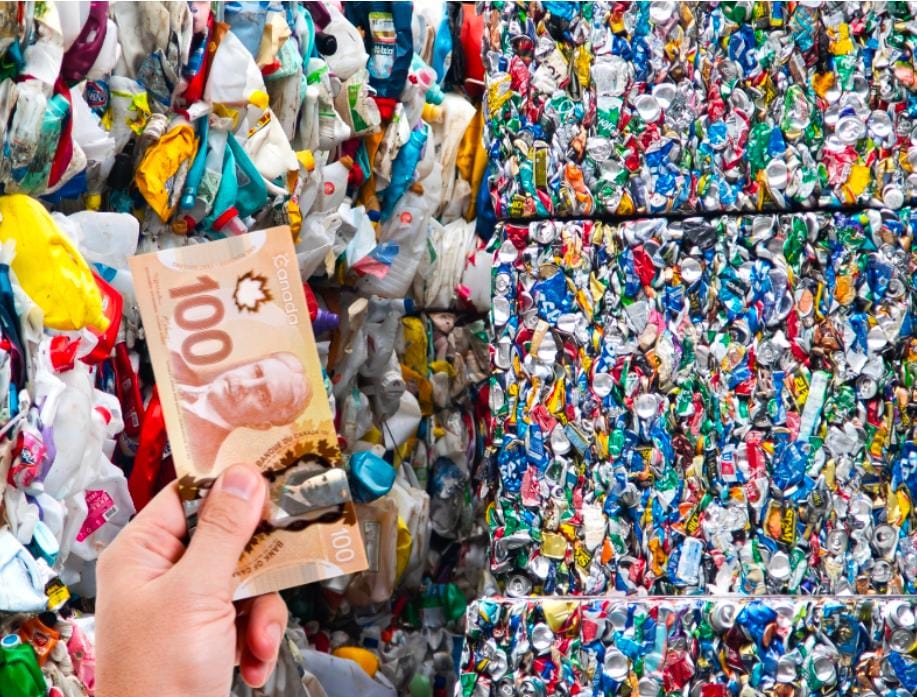You’ve stood in your kitchen, empty bottle in hand, wondering what to do next. Does the cap stay on? Do I need to rinse this out? We’ve all been there. It feels like it should be simple, but the rules can seem a little fuzzy.
That’s why we put together this complete bottle recycling tips guide. Making recycling a habit is so much easier when you know exactly what to do. You’ll feel good about helping the planet, and getting that deposit money back is a nice bonus, too.
This guide will clear things up for you. It’s time to make recycling simple and effective for everyone in your household. Let’s get started.
Why Bother with Bottle Recycling Anyway?
It’s a fair question with everything else going on. Recycling your beverage containers makes a huge difference for our environment and our economy. When you recycle plastic bottles, aluminum cans, and glass bottles, those materials get a second life.
These recycled materials are used to make new products, which use far less energy than creating them from scratch. This process helps conserve resources and reduces our reliance on raw materials. It also means less trash is piling up in our landfills, which helps reduce waste across the community.
According to the Alberta Bottle Depot Association, Albertans recycle over 85% of beverage containers sold. Every beverage container you return is one less piece of garbage sitting in the ground. Plus, recycling helps reduce greenhouse gases, as manufacturing with recycled materials is much more energy-efficient than using virgin resources.
Then there’s the money from the deposit refund. You paid a deposit on that container when you bought it. Bringing it back to a bottle depot in Calgary means you get that money back in your pocket.
Getting Your Bottles and Cans Ready: The Basics
A little prep work at home makes your trip to the bottle depot quick and easy. You do not have to spend a ton of time on this. Just a few simple habits will make the recycling process smooth for you and the depot staff.
To Rinse or Not to Rinse?
This is probably the most common question people have. You do not need to scrub your containers until they sparkle. But giving them a quick rinse is a really good idea to keep your containers clean.
Leftover pop, juice, or other liquids can get sticky and smelly. A quick rinse with water prevents your recycling bags from becoming a sticky mess and avoids attracting pests. Rinsing also prevents recycling contamination, which can ruin a whole batch of otherwise good recyclable materials.
Should I Crush the Cans?
It seems like crushing aluminum cans would save space, and it does. But hold off on stomping them flat just yet. Many bottle depots use scanners to read the barcodes on containers to sort and count everything accurately.
A completely flattened can is tough to scan. Lightly crushing beverage cans is usually okay, but your local depot might prefer them as they are. If you’re unsure, it’s best to leave them uncrushed to improve recycling efficiency at the facility.
Caps On or Caps Off?
The great cap debate can be confusing. For most plastic drink bottles in Calgary, you should leave the caps on. Modern recycling facilities are equipped to handle them, and the plastic in the cap can be recycled along with the bottle.
For glass bottles with metal caps, you should remove the caps. These materials are recycled differently, so separating them is important. A good rule of thumb is to keep plastic caps with plastic bottles and remove metal ones.
Your Ultimate Bottle Recycling Tips Guide for Calgary
Ready to become a recycling expert? Following a few simple steps can turn a chore into a quick and rewarding errand. It’s all about creating a simple system that works for you and your family.
Know What You Can and Cannot Return.
Not everything that looks like a beverage container is part of the deposit system. Knowing what to bring to the bottle depot saves you from sorting through things later. You’ll get a deposit refund on most ready-to-serve drink containers.
The Alberta Beverage Container Recycling Corporation (ABCRC) has a full list, but here’s a quick overview. This helps you know which items go to the bottle depot recycling and which go in your home recycling bin.
| Bring to the Depot | Put in Your Blue Bin |
|---|---|
| Aluminum and Tin Cans (Pop, beer, energy drinks) | Milk Cartons and Jugs |
| Plastic Bottles and Jugs (Water, pop, juice) | Soup Cans (e.g., Campbell’s) |
| Glass Bottles (Beer, wine, spirits) | Cleaning Product Bottles |
| Tetra Paks (Juice boxes, some soups/broths) | Coffee Cream Cartons |
| Drink Pouches (e.g., Capri Sun) | Whipped Cream Canisters |
One of the biggest mix-ups is with milk containers. In Alberta, milk cartons and jugs do not have a deposit on them. These should go into your blue recycling bin at home, not to the bottle depot.
Always check local recycling guidelines, as rules can vary based on your municipality. Some items have a specific recycling code that indicates their material type. While depots focus on beverage containers, understanding these codes can help with your general household recycling.
Sorting Your Containers for a Faster Trip
You can save a ton of time at the depot by sorting your containers at home. You don’t need a complicated system. Just have separate, clear bags or bins for different types of recyclable items.
Try sorting them into these groups: aluminum cans, plastic bottles, glass bottles, and Tetra Paks. When you arrive at the depot, the staff can count your pre-sorted containers much faster. This simple step helps the entire bottle return process run smoothly and gets you on your way quicker.
Choosing the Right Time to Go
Bottle depots can get very busy, just like a grocery store. If you want to avoid a long lineup, try to skip the peak times. Saturday afternoons and the day after a long weekend are usually the busiest.
Weekday mornings or afternoons are often much quieter. A mid-week trip can mean you’re in and out in just a few minutes. This can make the experience of depot recycling much more pleasant.
Understand the Alberta Deposit System
Knowing how the deposit works helps you know what to expect. You pay a small deposit every time you buy an eligible beverage container. You get that deposit back when you return the empty container for recycling.
The amount depends on the size of the container. This system is a great incentive that encourages high recycling rates for beverage containers.
| Container Size | Deposit Refund |
|---|---|
| 1 Litre or Less | 10 Cents |
| Over 1 Litre | 25 Cents |
These small amounts add up fast, especially for families. It’s an effective program that encourages everyone to participate in recycling bottles. More information on the system can be found on the Government of Alberta’s page.
What Happens After You Drop Off Your Bottles?
Have you ever wondered what happens to your bottles and cans after you leave the depot? They go on a fascinating journey to become something new. First, they are sorted by material type at the depot if you haven’t done so already.
Then, they are compacted into large blocks called bales for easier transport. The bales are shipped to different processing plants where the materials recycling begins. At these plants, the materials are cleaned and processed.
Aluminum cans are melted down and turned into new aluminum sheets to make more cans. Plastic bottles are shredded into small flakes of recycled PET. These flakes can be used to make new bottles, fleece jackets, or even playground equipment.
Glass is crushed into a material called cullet, which is melted to create new glass containers. The recycling process is a great example of a circular economy. Reusing recycled plastic and other materials saves raw materials and energy.
The Recycling Council of Alberta has more information on how this all works. This system significantly cuts down on the need for new plastic production from natural resources.
Common Mistakes to Avoid
A few common slip-ups can slow down your depot trip or reduce your refund. Luckily, they are all easy to fix. Here are a few things to watch out for to improve recycling habits.
- Leaving liquids inside. Make sure your containers are empty, as full or half-full containers are heavy, messy, and can’t be processed properly.
- Mixing in non-deposit items. Things like milk jugs or soup cans don’t have a deposit, so sorting them out at home saves time.
- Bringing dirty containers. While a deep clean isn’t needed, very dirty containers with food or other gunk can be rejected.
- Using the wrong bags. Clear bags are best because they let depot staff see what’s inside, which speeds up the sorting and counting process.
- Forgetting to remove straws from drink pouches. These small plastic items can contaminate the recycling stream and should be disposed of separately.
Recycling Beyond Bottles: What About Other Stuff?
Your local bottle depot is fantastic for beverage containers. But what about all the other recyclables in your home? Calgary has a great system for handling those items, too.
Your curbside collection bin is the place for many household items, including paper, cardboard, glass, and plastic food containers like yogurt tubs. It’s important not to mix your depot returns with your blue cart items. They go to different facilities and are processed in different ways.
For larger items or things you’re unsure about, the city has community recycling depots. These facilities accept things that don’t belong in your blue bin or at the bottle depot. You can find programs for electronics, scrap metal, and even hazardous waste.
Specialty recycling programs also exist for items like batteries and light bulbs. Check for local battery recycling drop-off points at retail stores or community centers. Light bulb recycling is also important, as many bulbs contain materials that shouldn’t go to the landfill.
The City of Calgary has an amazing tool called What Goes Where. You can type in any item, from a light bulb to an old TV for TV recycling, and it will tell you exactly how to dispose of it. This resource is perfect for when you need to check recycling rules.
Creative Ways to Repurpose Before You Recycle
Before you recycle bottles, think about whether you can give them another life. There are many creative ways to reuse glass and plastic bottles around your home. This approach helps reduce waste even further.
Glass bottles can be turned into beautiful vases, candle holders, or storage containers for dry goods like rice and pasta. Plastic bottles can be transformed into small planters for herbs, bird feeders, or watering cans for your garden. Finding new uses for items is a great way to conserve resources and save money.
Exploring these options is a fun and practical way to reduce your environmental footprint. The best recycling is to not have to recycle at all. It’s a great habit to get into for a more sustainable lifestyle.
Conclusion
Recycling your bottles and cans in Calgary doesn’t have to be a big deal. With a little bit of organization, it can become a simple and rewarding part of your routine. Remember to give your containers a quick rinse and sort them at home to make your depot trip a breeze.
You’ll be helping the environment, keeping our community clean, and earning a little cash back at the same time. This bottle recycling tips guide should give you the confidence to tackle that pile of empties like a pro. When you recycle plastic bottles and other containers, you support local businesses and help create a more sustainable future for everyone.






